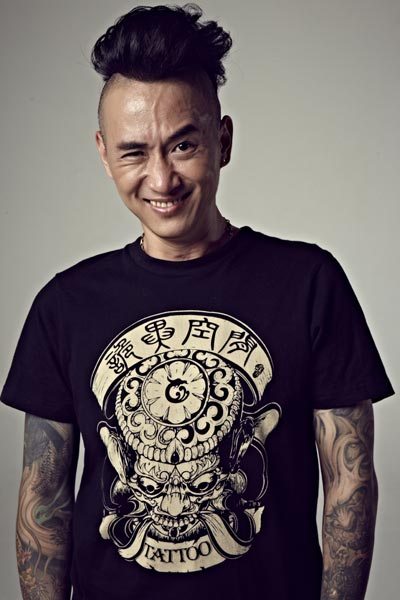 |
| Tattooist He Wenqian. Photo provided to China Daily. |
"Now, it's a great conversation starter."
Not only are the demographics getting tattoos diversifying but so are the images.
"People work with artists to create custom designs that share their personal stories," He says. "It's a whole different picture now."
Traditional subjects' allusions are changing, too. Dragons, pheonixes and Chinese ghosts remain the most popular. They used to be symbols of intimidation among street fighters. Now, they're simply auspicious icons.
"In the late 1990s and early 2000s, men who had these tattoos believed these patterns would make them look tougher and used different designs to indicate associations with social groups," China Association of Tattoo Artists chairman Wang Qingyuan explains.
"Now, they're just good luck emblems."
Women are more likely to get such likenesses as birds and flowers rendered in softer lines and brighter colors, Wang says.
English initials of names and quotes are increasingly prevalent. Some clients want to commemorate special moments, loved ones and parents by inking their initials on their bodies, He says.
Still, many among the younger generation hide their tattoos from their elders.
Chen Qimei, a mother and 34-year-old website editor, says she conceals her ink from her mother-in-law.
"I accidently exposed it to her once and told her it was only temporary," Chen says.
"But I'm more open-minded. I'd certainly let my child get a tattoo. Still, I'd warn her it's a lifelong decision that she should carefully consider."
Her first tattoo in 2005 wasn't about stylistic expression but rather to cover a scar on her left knee from a childhood accident.
"I really hated my scar," she says.
One day, she noticed several tattoo shops in Beijing's Longfusi area.
"The idea of covering the scar with a tattoo came to me," she recalls.
Her first tattoo experience wasn't as positive as her second and third.
"It hurt," she says.
"That artists didn't sterilize my skin or even wear gloves. For a long time, I worried I'd contracted HIV."
Later, after her fears of disease were allayed, she thought the rose on her kneecap could "bring more attention".
"Not so many people were familiar with tattoos as art in 2005," she recalls.
"People would stare at me when I walked on the street. They must have thought: ‘Why does this quiet, good girl have a tattoo on her knee?'"
Few would think anything of it today.


 Heavy cargo flights taking off
Heavy cargo flights taking off In pictures: PLA's digital equipment
In pictures: PLA's digital equipment  Americans mark Thanksgiving Day with parades
Americans mark Thanksgiving Day with parades Self-made farmer billionaire donates 69 villas at hometown
Self-made farmer billionaire donates 69 villas at hometown Demolition of bizarre rooftop villa in Beijing still in progress
Demolition of bizarre rooftop villa in Beijing still in progress Service seminar for E China train attendants
Service seminar for E China train attendants  Supermodel-turned-designer
Supermodel-turned-designer Cheerleaders light up CBA regular season
Cheerleaders light up CBA regular season  Finland--anytime you want is right time to go: Ambassador
Finland--anytime you want is right time to go: Ambassador Youths in Night club: photo story
Youths in Night club: photo story Models dazzle at Int'l Yacht Model Pageant
Models dazzle at Int'l Yacht Model Pageant  How to apply for a green card in China
How to apply for a green card in China Selected sports photos of the week
Selected sports photos of the week Annual Santa Claus parade held in Canada's Montreal
Annual Santa Claus parade held in Canada's Montreal China's aircraft carrier passes through Taiwan Strait
China's aircraft carrier passes through Taiwan StraitDay|Week|Month